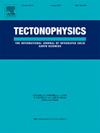Tectonic structures of SW margin of Gondwana from gravity and magnetic anomalies of the Río de la Plata area and their correlation with the Beattie magnetic Anomaly in South Africa
IF 2.7
3区 地球科学
Q2 GEOCHEMISTRY & GEOPHYSICS
引用次数: 0
Abstract
The Río de la Plata cratonic area and the adjacent continental platform (South America) have been subject of geophysical and tectonic studies for several decades. However, there are still many uncertainties related with its structural configuration and tectonic evolution. To deepen the knowledge of the tectono-structural characteristics of the cratonic and surrounding areas, we carried out an analysis of magnetic and gravity anomalies, which is highly effective in accurately locating the boundaries of crustal/lithospheric domains/terrains and structures. Additionally, this tectonic characterization allows us to correlate South American geophysical features with their counterparts in southern South Africa (i.e., Beattie Magnetic Anomaly).
In this study, different filters and techniques were employed to analyze magnetic and gravity anomalies. The gravity anomaly was obtained from global models, whereas the magnetic anomaly was compiled from diverse sources (aerial, terrestrial, and marine data). Particularly, the first vertical derivative, total horizontal derivative, analytic signal, tilt angle and upward continuations were calculated, and 3D Euler Deconvolution was applied.
Our results confirm the existence, and accurately determine the location, of Río Negro and Colorado transfer zones, Sierra de la Ventana Shear Zone, and extensional structures in the Tandilia System area, here defined as Tandil Trough. Moreover, we propose that the Sierra de la Ventana Shear Zone was shifted northwards in the offshore sector of the study area through sinistral displacement along the Punta Mogotes Shear Zone. Considering the similar rheological contrasts exhibited by the South African margin, we suggest an analogous configuration in the case of the Cape Fold Belt. Additionally, based on our interpretations, and considering previous geophysical studies, we support the proposal that the Beattie Magnetic Anomaly in South Africa and the magnetic anomaly detected beneath the Claromecó Basin would be generated by comparable sources (i.e., Sierra de la Ventana Shear Zone).
从拉普拉塔河地区的重力和磁异常现象看冈瓦纳西南边缘的构造结构及其与南非比蒂磁异常的相关性
几十年来,地球物理和构造研究一直在对拉普拉塔河板块地区和邻近的大陆平台(南美洲)进行研究。然而,其结构构造和构造演化仍存在许多不确定因素。为了加深对该板块及其周边地区构造结构特征的了解,我们对磁异常和重力异常进行了分析,这对准确定位地壳/岩石圈域/地层和结构的边界非常有效。此外,这种构造特征使我们能够将南美洲的地球物理特征与南非南部的对应特征(即比提磁异常)联系起来。在这项研究中,我们采用了不同的过滤器和技术来分析磁异常和重力异常。重力异常是从全球模型中获得的,而磁异常则是从不同来源(航空、陆地和海洋数据)中获得的。我们的研究结果证实了内格罗河和科罗拉多转移带、Sierra de la Ventana 剪切带以及坦迪利亚系统地区(此处定义为坦迪尔海槽)延伸结构的存在,并准确确定了其位置。此外,我们还提出,Sierra de la Ventana 剪切带是通过沿 Punta Mogotes 剪切带的正弦位移而在研究区域的近海部分向北移动的。考虑到南非边缘表现出的类似流变对比,我们认为开普褶皱带也有类似的构造。此外,根据我们的解释,并考虑到以前的地球物理研究,我们支持南非的 Beattie 磁异常和克拉罗梅柯盆地下探测到的磁异常由相似来源(即 Sierra de la Ventana 剪切带)产生的建议。
本文章由计算机程序翻译,如有差异,请以英文原文为准。
求助全文
约1分钟内获得全文
求助全文
来源期刊

Tectonophysics
地学-地球化学与地球物理
CiteScore
4.90
自引率
6.90%
发文量
300
审稿时长
6 months
期刊介绍:
The prime focus of Tectonophysics will be high-impact original research and reviews in the fields of kinematics, structure, composition, and dynamics of the solid arth at all scales. Tectonophysics particularly encourages submission of papers based on the integration of a multitude of geophysical, geological, geochemical, geodynamic, and geotectonic methods
 求助内容:
求助内容: 应助结果提醒方式:
应助结果提醒方式:


